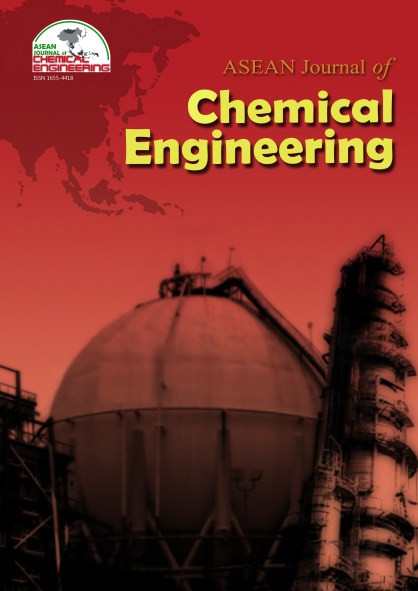Kinetics of Oil-in-Water Emulsion Stabilization using Lecithin and Biosilica
Abstract
Oil-in-water (O/W) emulsion has been widely used in food emulsions such as mayonnaise, dressings, and sauces. However, O/W emulsion is inherently thermodynamically unstable and easily destabilizes with time. Synthetic polymeric emulsifiers have been commonly used to stabilize these emulsions. However, those synthetic emulsifiers may induce obesity and other unexpected side-effects. In this experiment, bio-emulsifier mixtures consisting of soy lecithin and bio-silica were combined to stabilize the o/w emulsion in order to obtain more healthful food emulsions with acceptable quality. Lecithin concentrations were varied from 0.05-1.5% and concentrations of pure bio-silica particles derived from rice husks were in the range of 0.5-3%. The effects of the concentrations of these emulsifier mixtures on the O/W emulsions stability were studied. Additionally, the effects of storage temperatures on the O/W emulsions stability in the presence of both lecithin and bio-silica were investigated. The kinetics parameters of resulting O/W emulsions were analyzed using zero and first order kinetic models. In general, emulsions destabilized with time and followed the first order kinetic model. The destabilization rates of emulsions in the presence of emulsifier mixture would decrease by approximately 25-50% as compared to the destabilization rates of emulsions in the presence of lecithin or bio-silica as their sole emulsifier. Variations of lecithin and bio-silica concentrations in the emulsifier mixtures were not significant to the O/W emulsions stabilization. Furthermore, destabilization rate constants of O/W emulsions stored at the refrigerated temperature were ~2 times lower than those stored at room temperature.References
2. Binks, B. P. and Lumsdon, S.O. (2000). Catastrophic phase inversion of water- in-oil emulsions stabilized by hydrophobic silica, Langmuir, 16, 25392547.
3. Binks, B.P., Clint, J.H., Whitby, C.P. (2005). Rheological behavior of water- in-oil emulsions stabilized by hydrophobic bentonite particles, Langmuir, 21, 53075316.
4. Chevalier, Y. and Bolzinger, M.-A. (2013). Emulsions stabilized with solid nanoparticles: Pickering emulsions, Colloids and Surfaces A: Physicochemical and Engineering Aspects, 439, 2334.
5. Eskandar, N.G., Simovic, S., and Prestidge, C.A. (2011). Interactions of Hydrophilic Silica Nanoparticles and Classical Surfactants at Non-Polar Oil- Water Interface, Journal of Colloid and Interface Science, 358, 217225.
6. Koglin, A., Doetsch, V., and Bernhard, F. (2010). Molecular engineering aspects for the production of new and modified biosurfactants. In: Biosurfactants, vol. 672, R. Sen, ed, Springer, New York, 158169.
7. Levenspiel, O. (1999). Chemical Reaction Engineering, 3 rd ed. John Wiley & Sons, New York. 4147
8. Mirhosseini, H., Tan, C.P., Aghlara, A., Hamid, N.S.A., Yusof, S., and Chern, B.H. (2008). Influence of Pectin and CMC on Physical Stability, Turbidity Loss Rate, Cloudiness and Flavor Release of Orange Beverage Emulsion during Storage, Carbohydrate Polymers, 73, 8391.
9. Pichot, R., Spyropoulos, F., and Norton, I. T. (2010). O/W emulsions stabilised by both low molecular weight surfactants and colloidal particles: The effect of surfactant type and concentration, Journal of colloid and interface science, 352, 128135.
10. Pichot, R., Spyropoulos, F., and Norton, I.T. (2009). Mixed-Emulsifier Stabilised Emulsions: Investigation of the Effect of Monoolein and Hydrophilic Silica Particle Mixtures on the Stability Against Coalescence, Journal of Colloid and Interface Science, 329, 284291.
11. Simmons, A.L. , Schlezinger, J. J., and Corkey, B. E. (2014). What are we putting in our food that is making us fat? Food additives, contaminants, and other putative contributors to obesity,” Current obesity reports, 3, 273285.
12. Tempel, M.v.D. (1953). Stability of Oil- in-Water Emulsions II : Mechanism of The Coagulation of an Emulsion, Recueil des Travaux Chimiques des Pays-Bas, 72, 433441.
13. Wang, B., Wang, L. J., Li, D., Adhikari, B., and Shi, J. (2011). Effect of gum Arabic on stability of oil-in-water emulsion stabilized by flaxseed and soybean protein, Carbohydrate polymers, 86, 343351.
14. Wanli, K., Yi, L., Baoyan, Q., Guangzhi, L., Zhenyu, Y., and Jichun, H. (2000). Interactions between Alkali/Surfactant/Polymer and Their Effects on Emulsion Stability, Colloids and Surfaces A: Physicochemical and Engineering Aspects, 175, 243247.
Copyright holder for articles is ASEAN Journal of Chemical Engineering. Articles published in ASEAN J. Chem. Eng. are distributed under a Creative Commons Attribution-NonCommercial 4.0 International (CC BY-NC 4.0) license.
Authors agree to transfer all copyright rights in and to the above work to the ASEAN Journal of Chemical Engineering Editorial Board so that the Editorial Board shall have the right to publish the work for non-profit use in any media or form. In return, authors retain: (1) all proprietary rights other than copyright; (2) re-use of all or part of the above paper in their other work; (3) right to reproduce or authorize others to reproduce the above paper for authors’ personal use or for company use if the source and the journal copyright notice is indicated, and if the reproduction is not made for the purpose of sale.



